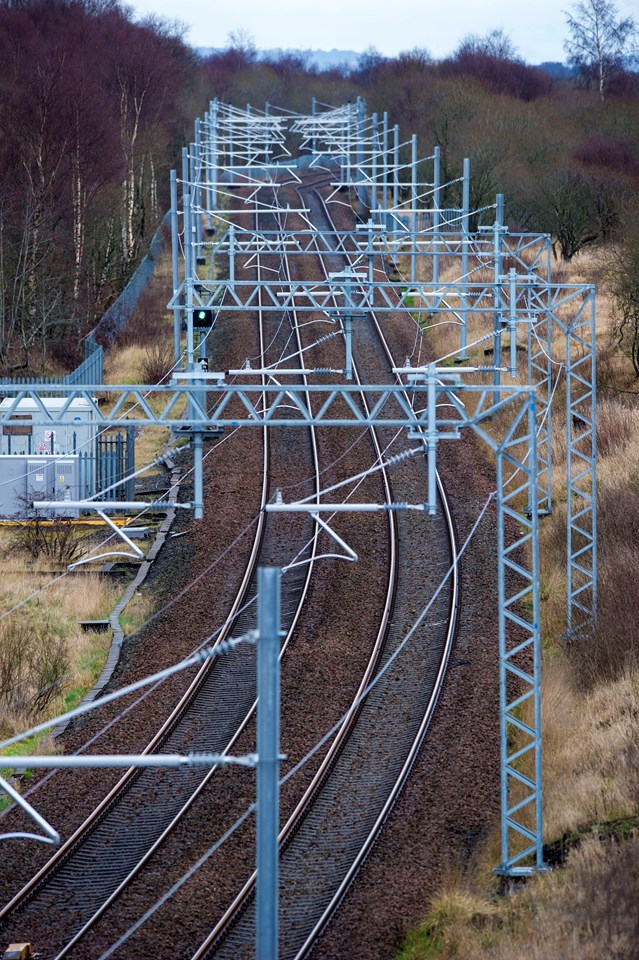Friday 2 Oct 2015
Edinburgh-Glasgow electrification work set to begin
- Region & Route:
- Scotland’s Railway: Scotland
Engineers will start to install overhead power cables on the main Edinburgh-Glasgow line this month (October) as work to electrify the route in 2016 gathers pace.
Part of the Scottish Government-funded, £742m Edinburgh-Glasgow Improvement Programme (EGIP), the electrification work will deliver faster, longer and greener trains for customers on the Edinburgh Waverley-Glasgow Queen Street line from December 2016.
Over the next six months, engineers will be installing stanchions to support the new overhead lines and stringing over 150km of power cables between the two cities – with the first sections of cable going up later this month.
Most of the electrification work will be carried out at night, but to help maximise the time engineers have to compete this complex work, some late evening service alterations will be in place.
After 21:30 on Sundays to Thursdays between October 5, 2015, and March 17, 2016, some services into Glasgow Queen Street – including the Edinburgh, Stirling, Alloa and Dundee trains – will be using diversionary routes and will have extended journey times. A limited number of stations will also be served by replacement bus services.
The evening alterations will be suspended over the Christmas period – from December 11 to January 2 – and full details of the changes can be found at www.scotrail.co.uk or by downloading the ScotRail journey checker app.
Rodger Querns, EGIP programme director, said: “The Edinburgh Glasgow Improvement Programme is a massive investment in Scotland’s railway that will help deliver long lasting benefits for both individual passengers and the wider economy.
“Electrifying the line between our two biggest cities will allow us to run faster, longer, greener trains and cut journey times while increasing the number of seats available.
“All the information that passengers will need to plan their journey during these improvement works is available on the ScotRail website and from National Rail Enquiries.”
-ends-
Notes to Editors
Service Alterations:
Glasgow Queen Street - Edinburgh
Trains diverted via Cumbernauld and Falkirk Grahamston, and will not call at Croy or Falkirk High.
Glasgow Queen Street - Falkirk Grahamston
Buses replace trains. Customers may use diverted Glasgow Queen St – Edinburgh services which call at Falkirk Grahamston.
Glasgow Queen Street - Stirling / Alloa / Dunblane / Dundee
Trains diverted via Cumbernauld and will not call at Bishopbriggs, Lenzie or Croy but will call at Springburn, Stepps, Gartcosh, Greenfaulds and Cumbernauld.
Balloch - Cumbernauld
Trains operate between Balloch and Springburn only. Customers travelling to Stepps, Gartcosh, Greenfaulds or Cumbernauld can complete their journey using Glasgow Queen Street high level train services; changing trains if necessary at Springburn.
Replacement buses
Buses will operate between Glasgow Queen Street and Falkirk Grahamston/Larbert calling at Bishopbriggs, Lenzie, Croy and Falkirk High. A shuttle bus will also run between Falkirk Grahamston and Falkirk High to connect with train services.
Some services are diverted and will have longer journey times and train departure times may be altered. Replacement buses may arrive/depart earlier or later than advertised train times.
Please visit www.scotrail.co.uk or download our app to check your journey.
Contact information
Passengers / community members
Network Rail national helpline
03457 11 41 41
Latest travel advice
Please visit National Rail Enquiries
Journalists
Network Rail press office - Nick King
Media relations manager (Scotland)
0141 555 4108 / 07515 617073
nick.king3@networkrail.co.uk
About Network Rail
We own, operate and develop Britain's railway infrastructure; that's 20,000 miles of track, 30,000 bridges, tunnels and viaducts and the thousands of signals, level crossings and stations. We run 20 of the UK's largest stations while all the others, over 2,500, are run by the country's train operating companies.
Usually, there are almost five million journeys made in the UK and over 600 freight trains run on the network. People depend on Britain's railway for their daily commute, to visit friends and loved ones and to get them home safe every day. Our role is to deliver a safe and reliable railway, so we carefully manage and deliver thousands of projects every year that form part of the multi-billion pound Railway Upgrade Plan, to grow and expand the nation's railway network to respond to the tremendous growth and demand the railway has experienced - a doubling of passenger journeys over the past 20 years.
Follow us on Twitter: @networkrail
Visit our online newsroom: www.networkrailmediacentre.co.uk

